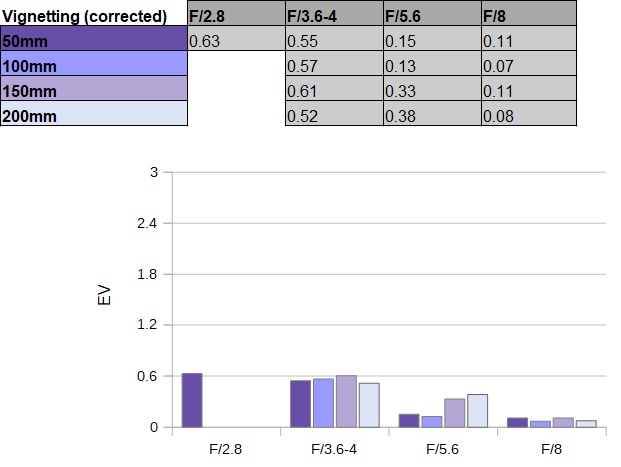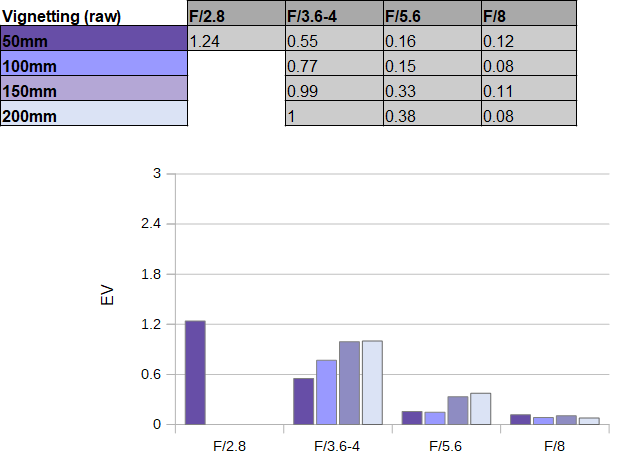|
Leica DG Vario-Elmarit 50-200mm f/2.8-4 ASPH Power OIS - Review / Test Report - Analysis |
|
Lens Reviews -
(Micro-)Four-Thirds
|
|
Page 2 of 3

Distortion
Micro-Four-Thirds cameras are using an auto-correction mechanism for image distortions thus there is nothing to worry about in this respect.
When looking into the RAW data, you can still determine the native distortion characteristic of the Leica lens. There are only slight pincushion distortions across the zoom range so the auto-correction doesn't have to be overly aggressive in the first place.
Vignetting
Vignetting is another aspect that is usually corrected under the hood thus the issue is basically negligible from an end-user perspective.
 If you choose to disable auto-correction, you will spot a more pronounced vignetting at fully open aperture with a maximum of 1.2EV (f-stops) at 50mm.
Stopping down by about 1 f-stop resolves the issue by most standards.
If you choose to disable auto-correction, you will spot a more pronounced vignetting at fully open aperture with a maximum of 1.2EV (f-stops) at 50mm.
Stopping down by about 1 f-stop resolves the issue by most standards.

MTF (resolution)
The Leica DG Vario-Elmarit 50-200mm f/2.8-4 ASPH Power OIS is very sharp across the entire zoom range. The center quality is excellent in the f/2.8 to f/5.6 aperture. The outer image field is very good to excellent at 50mm to 100mm and still very good beyond. The quality drops slightly at the 200mm setting but that's hard to notice in real life. Diffraction has a higher impact from f/11 onward.
The field curvature is very low. The centering quality of the tested sample was very good.
Please note that the MTF results are not directly comparable across the different systems!
Below is a simplified summary of the formal findings. The chart shows line widths per picture height (LW/PH) which can be taken as a measure for sharpness.
If you want to know more about the MTF50 figures you may check out the corresponding Imatest Explanations

Chromatic Aberrations (CAs)
Lateral CAs (colors shadows at the image borders) are very low and not relevant in real life.

Bokeh
The Leica DG Vario-Elmarit 50-200mm f/2.8-4 ASPH Power OIS is fast by Micro-Four-Thirds standards but its depth-of-field capabilities are, of course, limited compared to full format systems. Of course, it's still possible to isolate your main subject simply because you tend to frame it at fairly high object magnification with this lens.
Unfortunately, the bokeh is not without issues - specifically when it comes to out-of-focus highlights. You can easily notice that the inner zone of these discs is not only very busy, it's also uneven. It may relate to either an effect from the polishing of the aspherical elements or glued elements in the optical system. In any case, it's not ideal. It's not always obvious in real life though.
 As usual, the highlight discs deteriorate towards the image borders/corners as shown below. The effect is not overly pronounced though (here taken at around the 100mm mark). Stopping down reduces this (vignetting-)effect.
The general rendition of out-of-focus areas is Ok but it could be smmother. Hard edges are rendered too harshly. This is something that we also noticed in the Leica DG 100-400mm f/4-6.3 ASPH Power OIS but it's more pronounced here.
As usual, the highlight discs deteriorate towards the image borders/corners as shown below. The effect is not overly pronounced though (here taken at around the 100mm mark). Stopping down reduces this (vignetting-)effect.
The general rendition of out-of-focus areas is Ok but it could be smmother. Hard edges are rendered too harshly. This is something that we also noticed in the Leica DG 100-400mm f/4-6.3 ASPH Power OIS but it's more pronounced here.

|